![]() Sonja's c.v. | Sonja in exhibitions | Art reviews on Sonja's blog | Sonja's other projects | Sonja's Artworks arranged by Medium
Sonja's c.v. | Sonja in exhibitions | Art reviews on Sonja's blog | Sonja's other projects | Sonja's Artworks arranged by Medium
| I read about the villagers telling the story of an ancestor while the crippled sculptor created the ancestor's image in clay. | |||||||||||||||||||||||||||||||||||||||||||||||||||||||||||||||||||||||||||||||||||||||||||||||||||
|
It was mutual entertainment, they told him stories, and he illustrated them.
The sculptor claimed that the inspiration and power to make the faces came from the
ancestors themselves. Hemet sensed that it wasn't just humility of a talented man
speaking but the simple truth.
As the old man spoke the young sculptor worked quickly, each stroke of his fingers
seemed to follow the words of the story. His simple tools dug into the clay and found
the shape or the surface required to draw out of the clay mass the image.
6
Even trompe l'oeil paintings are more than meets the eye. We know it is a trick but does this affirm or challenge the idea of reality? |
|||||||||||||||||||||||||||||||||||||||||||||||||||||||||||||||||||||||||||||||||||||||||||||||||||
|
Then Tane Mahuta took some red clay and modelled the form in his own image.
Finally he breathed his breath into the nostrils and she awoke.
Hine ahu one, the Earth-formed woman, was our first mother.
7
|
|
There was green and sunshine all around as she entered the garden. All she had to do was to concentrate on the exceptions, the particularities, and there it was full of diversity. As time passed and her skin could breathe more of the garden, she realised that it was just habit that made the garment feel as if it was who she was. 11 |
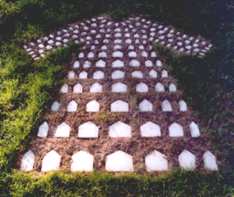
Memorials, installed in het Zuiderpark, den Haag, 1998, Sonja van Kerkhoff / Sen McGlinn. |
She felt she owed it to history
-for all the people and all the houses and all the streets still there-
to leave it there as a token of mercy.
As a reminder of what we can wear and transcend.
Craving for simplicity, People would say "What really matters are the colors." It is obvious that music is abstracted. No one would think of a song as being ´real´ yet we believe any particular colour is real because we see it rather than hear it. |
|
The hegemony of the eye is very strong in our culture. We are obsessed with the gaze. 12 Yet funnily even for the diehard I-am-alone-in-the-world artist, the art is still more than the material, more than the paint or what the artist consciously invests in her strokes. More than meets the eye. I am a container made out of clay that has been given the mystery of life. Myself now includes the rainforest. It includes clean air and water. 13 Care and compassion are tools of the soul, often ridiculed as subjective. The material is just part of the mystery. Connective aesthetics views human nature as deeply imbedded in the world. 14 That's mystery made into magic which uproots the religion of the commodity. "When I use a word," Humpty Dumpty said in rather a scournful tone, "it means just what I choose it to mean -neither more nor less." "The question is", said Alice, "whether you can make words mean so many different things." "The question is," said Humpty Dumpty, "which is to be master -that's all." 15 | |||||||||||||||||||||||||||||||||||||||||||||||||||||||||||||||||||||||||||||||||||||||||||||||||||
|
Dictionaries are maps not territory. |
|
A pretentious fatuous fool presumes a mastery over words and their meanings. A control over mystery. |
|
I was now vividly aware of myself as a person on earth, feeling a kinship with other creatures
and full of joy at the sights and sounds about me and drunk with the anticipation of play,
where playing seemed endless, on and on...
16
Is it utopian -and is that problematic?- to think of the everyday differently from the norm in the same way that poetry is different from a planning manual. The belief in the reality of everyday events is more to do with routine than with fact.
|
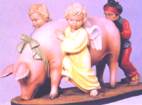 Ushering in banality by Jeff Koons. Collection: Stedelijk, Amsterdam.
And technology, that relentless magic show, has changed our lives while both enlarging and
shrinking the cultural field. It is now obvious that segments of society are not discrete
categories, but rather simultaneous processes that collide, seep, and withdraw with, into,
and from one another. Seeing is no longer believing.
17
| Now the day-to-day is the dream, which can be confusing or mysterious, yet at the same time liberating if we don't walk away muttering, "It's a mystery," as an excuse for our disengagement.
|
We will surely show them Our signs in the world and within themselves. 18 And also in your own selves: will ye not then behold the signs of God? 19 Humankind is My mystery, and I am humankind's mystery. 20 It is not possible to think of art without the mystery -the aesthetic. You might be weary of the aesthetic as Beckett was, but you can't be unaffected by it. This stress on the reality of the material without the mystery is a death. Reality for its own sake is a fetishism of the lost object: no longer the object of representation, but the ecstasy of denial and of its own ritual extermination: the hyperreal. Entertainment works by familiarizng the utopian. To make it seem real to be consumed and enjoyed. Much art works by distancing the familiar to invoke magic. And in turn we believe that artists are weirder and lonelier than we are, that paintings are less real than photographs, that stars are more interesting than we are, that those stories are more solvable than those we encounter. | ||||||||||||||||||||||||||||||||||||||||||||||||||||||||||||||||||||||||||||||||||||||||||||||||||||||||||||||||||||||||||||||||||||||||||||||||||||||||||||||||||||||||||||||||||||||||||||||||||||||||||||||||||||||||||||||||||||||||||||||||||||||||||||||||||||||||||||||||||||||||||||||||||||||||
|
Art is the imitation of nature in her manner of operation. Art is not nature and neither
is culture. Rather art distances - it exoticizes the material as a means to transform its
taken-for-granted associations.
He told me plainly and clearly, "Art is best when it serves itself and nothing else." "Who does it serve then?" I asked. "Art can't solve any problems but aesthetic ones," he hissed. |
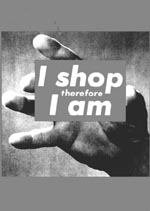
Untitled, 1987, photograph by Barbara Kruger. |
||||||||||||||||||||||||||||||||||||||||||||||||||||||||||||||||||||||||||||||||||||||||||||||||||
|
Christo, whose own work requires the participation and cooperation of thousands of people, says: The work is a huge individualistic gesture that is entirely decided by me... One of the greatest contributions of modern art is the notion of individualism. I think the artist can do anything he wants to do. This is why I would never accept a commission. Independence is most important to me. 21 The myth of the solitary genius -this notion of individualism has certainly colored the way we read art and how aesthetics works. |
|||||||||||||||||||||||||||||||||||||||||||||||||||||||||||||||||||||||||||||||||||||||||||||||||||
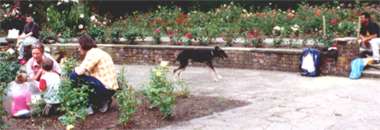
Living Creature, performance by S.Buist, G. Harting, J. Rahman, J. Wassen, W. van Egmond, J. van Stuijvenberg, S. van Kerkhoff & T. McGlinn. |
The Living Creature was us and what we did and what happened in a particular gallery and garden.
Some of us talked and explained, some of us concentrated on working with our hands, others
fed and entertained. It was hard to say, who played the main role and who played a minor one. Aspects of the event, -yes it was a event, it had a beginning, an end and a location- could be described and analysed. |
|
Jacqueline spread things around her suitcase and proceeded to paint. Wim showed people how to look through the microscope. Geeske took a thorn and surrounded this with a circle of its likeness. Sarah asked people to write out a word. These artists chose interaction as their medium rather than the disembodied eye. |
|
Yet how can
I describe what really happened as a totality. I have to choose a particular viewpoint
and as soon as I do that, there's a danger of emphasizing the individualistic gesture
at the expense of the organic nature of the happening.
The material itself doesn't lead to a particular effect. Yellow for one is grey to another. |

Nature is a law of nature, London, 1996, performance by Sonja van Kerkhoff. |
|
Complexity generates mystery.
A system is more than its parts, but just how is a mystery.
Yet it's not mystifying. |
|||||||||||||||||||||||||||||||||||||||||||||||||||||||||||||||||||||||||||||||||||||||||||||||||||
| Social context becomes a continuum for interaction, for a process of relation and weaving together, creating a flow in which there is no spectatorial distance, no antagonistic imperative, but rather the reciprocity we find at play in an ecosystem. To follow this path, I would argue, is more than just a matter of personal taste; it represents the opening of an experimental space in which to institute and practice a new art that is more in tune with the many interactive and ecological models emerging in our culture. I believe we will see over the next few decades more art that is essentially social and purposeful, and that rejects the myths of autonomy and neutrality. 22 |

I believe it is an image in light of the Other, 1991, video installation, by Gary Hill, van Abbemuseum, Eindhoven. |
||||||||||||||||||||||||||||||||||||||||||||||||||||||||||||||||||||||||||||||||||||||||||||||||||
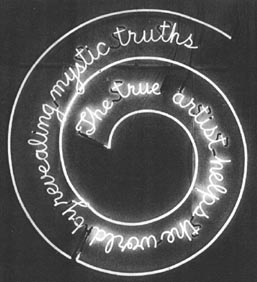
Bruce Nauman, Window or Wall Sign, 1967, Kröller Muller Museum.-text on neon tube: The artist helps the world by revealing mystics truths |
The dream space of the soul is the terrain that artists map. As Beuys could have said, that's everyone's map. 23 Sonja van Kerkhoff / Sen McGlinn |
||||||||||||||||||||||||||||||||||||||||||||||||||||||||||||||||||||||||||||||||||||||||||||||||||
|
Afterthought: I chose a lyrical approach for my contribution to the theme material/mystery because, while I wanted to raise issues to with ´reality´ or symbiotics, I didn't want to address ´truth´ as the issue (the modernist vs postmodernist argument as I see it). Instead my perspective was to show how complex and multi-faceted and ´real´ the theme material/mystery is and to leave us with the thought that it is not such a mystery that the plastic arts are or can have close links with the social. NB: We felt that using the singular, I, in referring to the author was best for this presentation. |
|
Footnotes |
|||||||||||||||||||||||||||||||||||||||||||||||||||||||||||||||||||||||||||||||||||||||||||||||||||
|
Where a text is paraphrased 'See:' is in front of the reference.
1. Bedankt aan Juul Sadée, Martin de Wit en Wim Nispen voor deze vertaling. Back to the text 2. Rebecca Horn, catalogue,1993, foreward by Thomas Frens:9 Back to the text 3. See: Barbara Kruger Remote Control -Power, Cultures, and the World of Appearances, 1993: 99-100 Back to the text 4. See: Michel Foucault, 1986, Of Other Spaces, Diacritics 16:22 Back to the text 5. John Cage, 1969, Silence:98 Back to the text 6. Joseph Sheppherd, 1997, The Island of the Same Name:170 Back to the text 7. New Zealand Maori creation story. Back to the text 8. See: Andrea Fisher's essay, The Times, in, 1993, (ed. Ole Bouman) And justice for all... :161-163 Back to the text 9. See: Waterland by Graham Swift, p 121, cited in Ernst van Alphen's essay, The performativity of histories, 1994, (ed. Mieke Bal & Inge de Boer), the point of theory:203 Back to the text 10 (Italics are ours) Edward Soja, 1993, History: Geography: Modernity, in (ed. Simon During) The Cultural Studies Reader:140 Back to the text 11. See: Sonja van Kerkhoff, 1996, Memorials / Gedenktekens, Back to the text 12. See: Suzi Gablik, 1995, Connective Aesthetics: Art after individualism,in Mapping the Terrain (ed. Suzanne Lacy):83-86 Back to the text 13. John Seed, Australian deep ecologist cited by Suzi Gablik, 1995, ibid:84 Back to the text 14 See: Suzi Gablik, 1995, ibid:83-86 Back to the text 15. Lewis Carroll(1899)reprint 1968, Alice's Adventures in Wonderland:222 Back to the text 16. John Cage, 1969, Silence:98 Back to the text 17. Barbara Kruger, 1993:2 Back to the text 18. Qur'án, 41:53 Back to the text 19. Qur'án, 51:21 Back to the text 20. Bahá'lláh, (1861) edition:1982, Kitab-i-Iqan:101 Back to the text 21. Interview in Flash Art, cited in Gablik, 1993:78 Back to the text 22. See: Suzi Gablik, 1993:86-7 Back to the text 23. See: Joseph Beuys' 1972 essay, "Not Just A Few Are Called But Everyone", in Art in Theory:889 Back to the text |